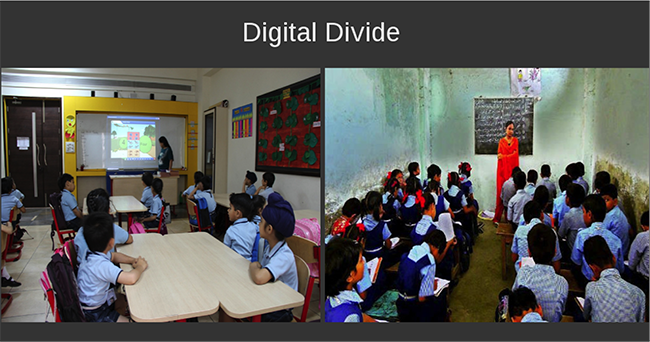
DIGITAL EDUCATION DIVIDE
WHY IN NEWS?
- A recent report on the latest National Statistical Organisation (NSO) survey shows the stark digital divide across States, cities and villages, and income groups.
- Schools across the country are closed for six months due to Covid-19. This means vastly different things for different people like many who have access to digital resources are getting online education, those who do not have such resources are devoid of education.
KEY POINTS
- Access to Computers and Internet:
- Across India, only one in ten households have a computer — whether a desktop, laptop or tablet.
Almost 25% of all homes have Internet facilities, accessed via a fixed or mobile network.
- Urban-Rural Divide:
Most of the Internet-enabled homes are located in cities, where 42% have Internet access. In rural India, however, only 15% are connected to the internet.
- Access and Utilization Gap: 20% of Indians above the age of 5 years had basic digital literacy,
REGIONAL DISPARITY
- The national capital has the highest Internet access, with 55% of homes having such facilities.
- Himachal Pradesh and Kerala are the only other States where more than half of all households have Internet.
- Odisha is at the bottom with only one in ten homes having Internet.
- There is less than 20% Internet penetration, even in States with software hubs such as Karnataka and Tamil Nadu.
DISPARITY DUE TO ECONOMIC STATUS:
- The biggest divide is by economic status, which the NSO marks by dividing the population into five equal groups, or quintiles, based on their usual monthly per capita expenditure.
- Even in Odisha, almost 63% of homes in the top urban quintile have Internet facilities.
- In the poorest quintile of rural Odisha, however, that figure drops to an abysmal 2.4%.
INTRA-STATE INEQUALITY:
- Kerala shows the least inequality with more than 39% of the poorest rural homes having Internet, in comparison to 67% of the richest urban homes.
- Himachal Pradesh also fares well, with 40% of the lowest rural quintile having Internet.
- Assam shows the starkest inequality, with almost 80% of the richest urban homes having the Internet access denied to 94% of those in the poorest rural homes in the State.
GOVERNMENT INITIATIVES:
- The Centre has directed State Education Departments to map the online access available to all their students in order to adequately plan curriculum and teaching methods that can reach such students.
- New Education Policy: National Education Policy, 2020 aims at making “India a global knowledge superpower” by introducing several changes from the school to college level in the Indian education system with special emphasis on digital education.
- DIKSHA (Digital Infrastructure for Knowledge Sharing) platform- DIKSHA is the national platform for school education available for all states and the central government for grades 1 to 12 and was launched in September 2017.
- As part of PM eVidya announced under the Atmanirbhar Bharat programme, DIKSHA is the ‘one nation; one digital platform’ for school education in India.
- Swayam Prabha TV Channel- To support and reach those who do not have access to the internet.
- Online MOOC courses- Online Massive Open Online Course MOOC courses relating to NIOS (grades 9 to 12 of open schooling) are uploaded on SWAYAM portal; around 92 courses have started and 1.5 crore students are enrolled.
- On Air – Shiksha Vani, DAISY by NIOS for differently-abled, e-PathShala- Radio broadcasting is being used for children in remote areas who are not online (especially for grades 1 to 5).
WAY FORWARD
To begin with, we need to promote and ensure digital literacy among the masses, primarily uninterrupted Internet connectivity and mobile network signals in rural areas.
